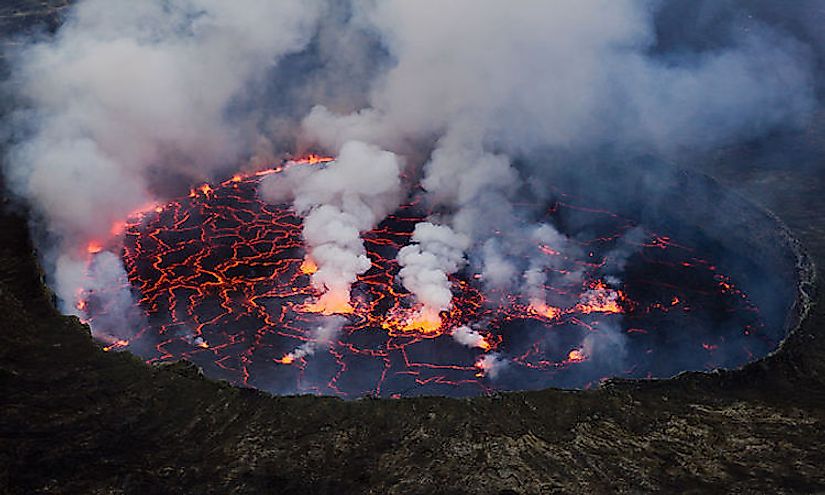UNESCO World Heritage Sites In The Democratic Republic Of The Congo (Congo-Kinshasa)

Congo-Kinshasa’s five sites represent some of the largest, most biodiverse, and most endangered natural reserves on earth. All of Congo-Kinshasa sites are natural, and they pride in exceptional rich biodiversity. The Democratic Republic of Congo is considered the wealthiest African country regarding flora and fauna. This biodiversity has been protected in some reserves, some of which have been declared as heritage sites due to their biological and ecological significance.
UNESCO World Heritage Sites In The Democratic Republic Of The Congo
Garamba National Park
The Garamba National Park has been a world heritage site since 1980. The park was founded in 1938, and it is one of the oldest national parks in Africa. The Garamba National Park is a vast expanse of guinea savanna and open woodlands. Numerous permanent water bodies in the park facilitate the survival of the rich flora and fauna. The park is home to some African iconic animal species such as the white rhino, elephant, hippopotamus, Congo giraffe, spotted hyena, lion and the chimpanzee. Due to poaching, only about 30 specimens of the white rhino remain.
The Garamba National Park is significant since it is located in the transition zone between the dense and humid forest ecosystems and the Savannah. Due to its location, the park boasts an impressive variety of flora and fauna. Protection of the park is occasionally hampered by rebel groups, and poaching remains one of the significant threats to its sustainability.
Kahuzi-Biega National Park
The Kahuzi-Biega National Park was listed as a World Heritage Site in 1980. The park encloses a mountain range dominated by the extinct peaks of Kahuzi and Biega. The park was founded in 1970, primarily to protect the Eastern Lowland Gorilla species. The park straddles the Congo Basin and the Albertine Rift, and it is characterized by dense lowland rainforest and montane forests. The forests provide habitats to the eastern lowland gorillas, red face chimpanzee and forests elephants among other fauna species. Poaching has severely affected the sustainability of the gorillas and elephants. Agricultural activities and illegal mining have led to degradation of the park’s habitats. The presence of militant groups impedes on the effective protection of the park. The park has been subsequently listed as endangered.
Okapi Wildlife Reserve
The Okapi Wildlife Reserve was listed as a UNESCO World Heritage Site in 1996. The reserve encompasses nearly one-fifth of the Ituri forest, situated in the northeastern part of the country. The Ituri rainforest mainly supports a high level of endemism. The Okapi Wildlife Reserve was founded in 1992, primarily to protect the Okapi. The reserve boasts the world’s largest population of the Okapi, which is a spectacular forest giraffe. Other fauna includes the bonobo, elephant, gorilla, dwarf elephant and forest buffalo. The reserve is also home to the aboriginal Mbuti and Efe pygmies, and the forest is culturally significant to them.
Although protection of the reserve is well provided for, threats such as rebel groups and poachers’ syndicates continue to threaten the reserve’s wildlife and habitats. The reserve is listed as endangered a situation which has raised the environmental alarm for it is one of the most biologically rich of the UNESCO World’s Heritage Sites.
Salonga National Park
Salonga National Park has been a World Heritage Site since 1984. The park stretches over an area of 36,000 km2 in the Congo River Basin. The park protects the dense rainforest and is only accessible by water or air. The park is renowned for having species such as the dwarf chimpanzee, bonobo, forest elephants and the African slender-snouted crocodile. The rainforest is also environmental significant for climate regulation and the sequestration of carbon. The park is home to a population of pygmies and local people. Poaching and rebel groups are continuously threatening the park’s wildlife. Efforts by the government and UNESCO have been ramped up to adequately address these concerns.
Virunga National Park
Virunga National Park has been a natural World Heritage Site since 1979. The park stretches for 7,800 km2 between the southern Virunga Mountains and the northern Rwenzori Mountains. The park is home to a variety of habitats including steppe, swamps, snowfields, lava plains, Afro-montane forests, savanna and Afro-alpine vegetation. The habitats support a rich biodiversity such as the mountain gorillas, hippopotamus, elephants, buffalo, chimpanzee and 709 bird species and 78 amphibian species.
Protection of the park is severely challenged by the presence of militant groups and proliferation of poaching. Deforestation has also cleared a significant part of the park’s forest cover. Plans for oil exploration by an oil company based in the UK have raised concerns over the potential environmental impacts. The park is listed as endangered.
World Heritage Sites In Danger
The Democratic Republic of Congo’s natural wealth has fueled years of political instability and strife. Rebel groups have time and again hindered government’s efforts, including the protection of the country’s heritage sites. All of the UNESCO World Heritage Sites in the country are listed as endangered. Blessed with a rich biodiversity, the country’s potential tourism remains highly untapped.
UNESCO World Heritage Sites In The Democratic Republic Of The Congo (Congo-Kinshasa)
| UNESCO World Heritage Sites in the Democratic Republic of the Congo (Congo-Kinshasa) | Year of Inscription; Type |
| Garamba National Park | 1980; Natural Site in Danger |
| Kahuzi-Biega National Park | 1980; Natural Site in Danger |
| Okapi Wildlife Reserve | 1996; Natural Site in Danger |
| Salonga National Park | 1984; Natural Site in Danger |
| Virunga National Park | 1979; Natural Site in Danger |







